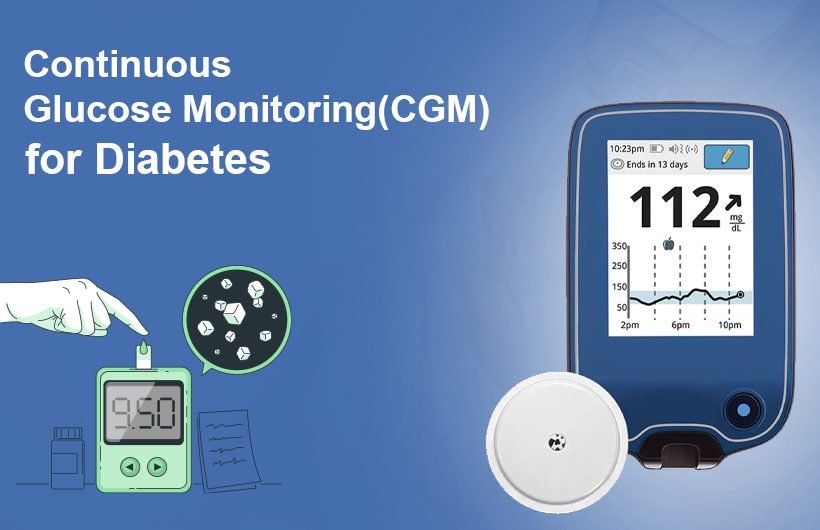What is Continuous Glucose Monitoring (CGM)?
Continuous Glucose Monitoring (CGM) is a method that provides real-time tracking of blood glucose levels. Unlike traditional glucose testing, CGM devices continuously monitor glucose levels throughout the day and night, offering insights into blood sugar patterns and trends over time. This constant feedback can be essential for people with diabetes, as it helps them better understand how various factors, such as food, exercise, and medication, impact their blood sugar levels.
How Does a Continuous Glucose Monitor Work?
A CGM system consists of three main components: a sensor, a transmitter, and a display device.
- Sensor: The sensor is a tiny device inserted under the skin, typically on the abdomen or arm, which measures glucose levels in the interstitial fluid.
- Transmitter: This component wirelessly sends the glucose data from the sensor to a display device.
- Display Device: The data can be viewed on a dedicated receiver or synced to a smartphone app, providing users with real-time updates on their glucose levels.
The CGM continuously estimates glucose levels and updates readings approximately every five minutes. Some systems also offer alerts for high or low glucose levels, enabling timely interventions
What Are the Different Types of Continuous Glucose Monitors?
- Real-Time CGM: It sends alerts if levels fall outside a user-defined range, these provide continuous real-time glucose readings.
- Intermittent-Scanning CGM: These do not automatically display data in real time but require the user to scan the sensor periodically to get glucose readings.
- Professional CGM: These are used in clinical settings for short-term monitoring and typically require downloading data for analysis by healthcare providers
Benefits of a Continuous Glucose Monitor
The benefits of continuous glucose monitoring for diabetes management are significant:
- Real-Time Data: Users receive continuous updates on their glucose levels, allowing for immediate adjustments in diet or insulin administration.
- Trend Analysis: CGMs help identify patterns in blood sugar fluctuations, providing insights into how food, exercise, and medication affect glucose levels.
- Reduced Hypoglycemia Risk: Alerts for high or low blood sugar can prevent dangerous situations, particularly during sleep or exercise.
- Improved A1C Levels: Studies have shown that using CGMs can lead to better overall blood sugar control and lower A1C levels.
- Convenience: With less need for finger pricks, CGMs offer a more comfortable method of monitoring diabetes.
Types of CGM Devices
There are several types of CGM devices available on the market, each with unique features:
- Freestyle Libre: An isCGM system that provides readings upon scanning the sensor.
- Dexcom G6: An rtCGM device offering continuous data without requiring user calibration.
- Guardian Connect: Medtronic’s rtCGM device predictive alerts to warn of potential blood sugar fluctuations.
Who Should Use Continuous Glucose Monitoring (CGM)?
Continuous glucose monitoring is ideal for:
- Type 1 Diabetes: Those who require insulin therapy can greatly benefit from real-time glucose monitoring.
- Type 2 Diabetes: Patients who struggle with blood sugar control despite medication may find CGMs helpful.
- Frequent Hypoglycemia: Individuals experiencing recurrent low blood sugar episodes can use CGMs to monitor their levels closely.
- Pregnancy: Pregnant women with diabetes may also be recommended to use CGMs to ensure stable glucose levels for both mother and baby
Conclusion
In summary, diabetes can indeed cause unusual sweating patterns due to fluctuating blood sugar levels. Continuous Glucose Monitoring (CGM) offers a valuable solution by providing real-time awareness of glucose trends, helping users prevent high and low blood sugar events. The benefits of CGM go beyond improved blood sugar control, it also brings peace of mind, better lifestyle adaptability, and a proactive approach to diabetes management. For those who experience hypoglycemia again and again or have challenges maintaining stable blood glucose, CGM is an invaluable tool that empowers users to make informed decisions for better health and overall well-being. Dr Moxit Shah, the Endocrinologist Specialist in Ahmedabad, emphasizes that monitoring these fluctuations with tools like Continuous Glucose Monitoring (CGM) can help manage symptoms and improve overall glucose control.






